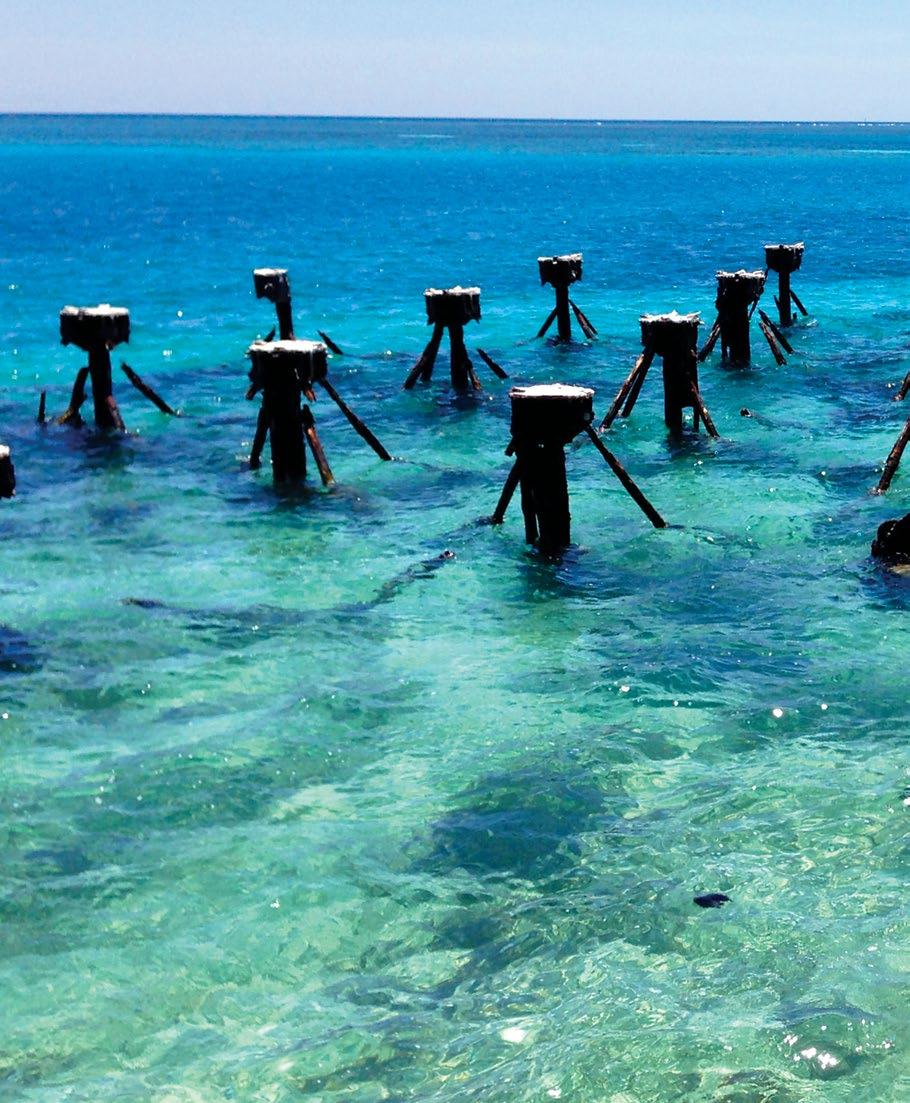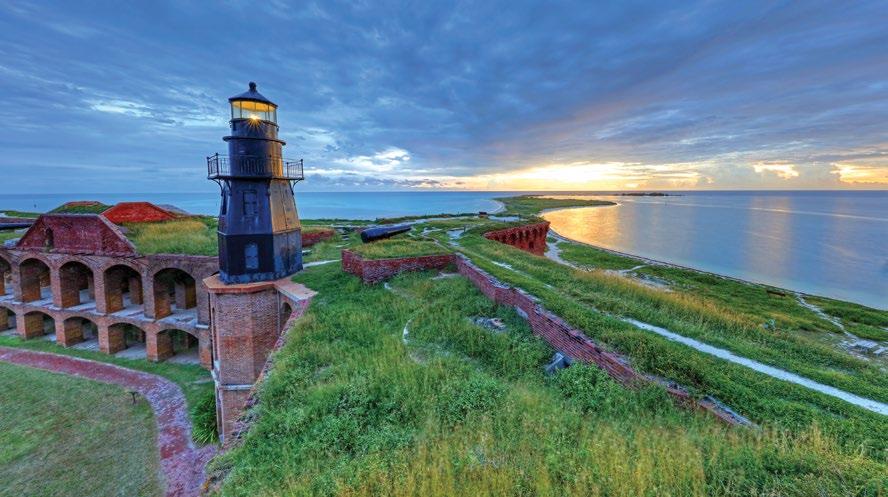
10 minute read
Dry Tortugas: Dive Into History
DRY TORTUGAS:




Departure was scheduled for sunset from Marco Island’s Capri Pass, for our transit of 94.4 nautical miles. A night arrival at the reef-encircled Dry Tortugas would be foolhardy, so our fl oat plan called for nighttime passage with arrival scheduled shortly after dawn. Darkness fell on the Gulf of Mexico, and we settled into rotating watches of two crew on deck.




Our vessel, the 52-foot Irwin ketch, Northern Light, was propelled along on a broad reach by strengthening winds. At one point, we counted 65 shrimp boats along the horizon, lit up like Christmas trees by their working deck lights. They were trawling for Key West Pinks, harvested from fi sheries between the Dry Tortugas and the mainland, so desirable they are referred to as “pink gold.” Later, it was just the constellations lighting up the moonless night sky.
Northern Light was screaming like a freight train, so we shortened sail to delay our arrival until civil dawn lit the morning sky. After clearing Iowa Rock’s fl ashing green, we entered the Tortugas anchorage, deployed the

hook, and exclaimed “What an incredible ride, and what a remote and beautiful harbor!”
We might have been channeling Ponce de Leon, the fi rst European to set foot here in 1513. Then, the islands were originally named Las Tortugas (The Turtles), and later began to appear on navigational charts as the Dry Tortugas to notify mariners that there was no freshwater to be found. But there were plenty of treacherous shoals, so in 1825, a lighthouse was built on Garden Key to warn sailors of the numerous coral reefs scattered throughout the area.
Construction of what was to become one of the largest brick structures in the Western hemisphere, called Fort Jefferson, began in 1846.


Designed to fortify the location and control navigation in the Gulf of Mexico, the fort also would protect Atlantic-bound Mississippi River trade. Yet the fort never saw military action — in fact, the 30-year-long construction project was never fi nished. During the Civil War, it served as a Union military prison for deserters and housed four men implicated in President Abraham Lincoln’s assassination, including Dr. Samuel Mudd, imprisoned for providing medical treatment to the assassin. By the 1880s, having outlived its already limited usefulness, the fort was abandoned by the military.
The next incarnation of the Dry Tortugas was a precursor of its mission today, when it was named a wildlife refuge in
1908. It became Fort Jefferson National Monument in 1935, and fi nally received its designation as the Dry Tortugas National Park in 1992. It now serves to guard the area not for military purposes, but to protect the area’s historic and natural wonders.
EXPLORING THE PARK Garden Key is the centerpiece of the park, which is open year- round and is home to Fort Jefferson, complete with a moat. The iconic masonry fort — 16 million bricks, give or take — encloses the visitor center, which provides an orientation to the area; here, a fort tour is a must. The parade ground is surrounded by 45-foot-high walls and features remnants of the old offi cers’ quarters, barracks, ammunition magazines and a restored hotshot furnace.
If you can’t come on your own boat, you can visit the park by seaplane with Key West Seaplane Adventures or the Yankee Freedom III National Park Ferry, both from Key West. In fact, most visitors arrive on the ferry and are day-trippers, with a limit of 330 visitors per day. Both modes of conveyance include your park admission and a guided tour of the fort; the ferry trip also includes breakfast, lunch and snorkel gear.
When we first visited Dry Tortugas, pre-COVID, the rangers conducted fascinating nighttime lantern-lit tours in period costumes. While the fort is not currently conducting those and is open only during daylight hours, there are plans to revive the Living History evening tours in the summer of 2021.
There is space for a few campers on Garden Key at the 12-site primitive campground, so you’ll likely see camping gear and kayaks on the ferry trip to the island. The only service for campers is composting toilets. The park is a pack-in, pack-out area, so take your trash with you on departure. Remember the Tortugas are “Dry” — this means no freshwater, so there are no showers and you must bring your own drinking water. Reservations are recommended; the fee is $15 per campsite per night for up to six people, and fi res are limited to charcoal grills. The reservation system, currently fi rst-come-fi rstMORE INFORMATION AND RESOURCES ■ Dry Tortugas ■ Virtual ■ Key West
National Park Underwater Tour Seaplane
305-242-7700 During the Adventures NPS.GOV/DRTO pandemic, take a 305-293-9300 virtual underwater KEYWESTSEAPLANE ■ Dry Tortugas tour of Dry CHARTERS.COM National Park Tortugas National Ferry Park with Lead 800-634-0939 Ranger Curtis Hall DRYTORTUGAS.COM at ARTSANDCULTURE
WITHGOOGLE.COM




served, is anticipated to transition online in the spring of 2021. Quiet hours are from 10 p.m. to 6 a.m. (meaning no generator use in the harbor or on land), during which time you are also asked to observe a dark sky/no bright lantern custom — well worth it when you can see the stars without interference of ambient light. Pets are only allowed on Garden Key, and in that case must be leashed.
SOCIAL DISTANCING IS THE NORM While not the least-visited National Park in the contiguous 48 states — that distinction goes to Michigan’s Isle Royale National Park in Lake Superior — the Dry Tortugas is among the least visited, and one of the few island National Parks. In fact, it encompasses seven undeveloped islands nestled among coral reefs and shipwrecks. The ideal way to see the breadth and depth of the park is to come on your own boat and anchor in Garden Key’s harbor for several days of dinghy exploration to the other six islands, which are not usually visited by day-trippers.
If you come on your own craft, the most direct route is from Key West; you’ll head just over 57 nautical miles west, passing by the Marquesas Keys about 20 nautical miles into your trip. Stop there only if the weather is ideal, as the surrounding low islands will provide only partial protection and the anchorage is very shallow — you don’t want to end up like the infamous Atocha, shipwrecked here. NOAA Nautical Chart No. 11438 will help you keep in good water.
Once you’re securely on the hook at Garden Key’s anchorage, take your dinghy in to pick up your permit at the Garden Key Visitor Center or park headquarter’s offi ce. The vessel registration is free, but you’ll need a $15, seven-day pass for each crew member. Any kayaks brought on the ferry must also receive permits at the offi ce. There, you can pick up information on restricted areas within the park, scope out hiking trail maps and check out general park information. Two islands — Hospital and Long Keys — are

closed year-round, and visitors should remain 100 feet offshore of these islands. You may also experience some seasonal closures of delicate areas due to bird nesting, and should always refrain from taking shells, corals, sea fans, or any shipwreck artifacts.
UNDERWATER PARADISE As the Dry Tortugas’ lead ranger of interpretation, education and volunteers, Curtis Hall’s love affair with the park goes way back. A native of Marathon in the Florida Keys, he fi rst visited the Dry Tortugas when he was 3 years old on his father’s charter fishing boat. Hall explains that the Dry Tortugas is the healthiest part of the 200-milelong Florida Keys Reef Tract, the only living barrier reef in North America, and anchors its western end. With 99% of the park underwater, and part of the Florida Keys National Marine Sanctuary, snorkeling and diving are big all year long; however, Hall notes “Summer brings 80plus feet of underwater visibility, so snorkeling and diving are at their absolute best then.”
Over 300 shipwrecks lie within the park’s 100 square miles, and many are perfect for snorkelers, with some sites as shallow as 6 feet. Many historic wrecks were carrying building material for the park, which can still be spotted laying on the sandy bottom, and the surrounding areas feature an abundance of sea fans, corals and marine life.
Hall knows his underwater neighborhood, as he also serves as deputy park dive officer. With so many wrecks in the park, it’s hard to pick favorites, but Hall says “My top spots for snorkeling are at the south end of Loggerhead Key, nearby Little Africa Reef, and our most famous and brilliant wreck, the ill-fated Windjammer.” As corals are in decline globally, you’ll be heartened by a visit to Pulaski Shoals in the northeast corner of the park, where Staghorn corals grow 100 yards thick in 8 feet of water — a truly incredible sight.
Ranger Hall’s background includes serving as a Navy Special Operations Diver and, as an expert on the subject, he


recommends divers head for the Texas Rock mooring sites and the Maze. Remember to stick to the designated swim areas or use a dive fl ag if you venture beyond them. In 2021, look for the introduction of a submerged snorkel trail right off Garden Key, complete with descriptive markers and, at a future point, a planned underwater Heritage Trail designed for diving.
Ranger Hall notes the attraction of the park varies by season. Birding enthusiasts will flock here in spring and fall, when the Dry Tortugas are on the principal fl yway between North America and South America for migratory birds, while gulls, terns and other shorebirds winter here. Between mid-January and mid-October, as many as 100,000 sooty terns nest on Bush Key — its rookery is visible with fi eld glasses from the fort. They share the island with 10,000 breeding brown noddies. You can watch both feed by capturing fi sh and squid from the sea in mid-fl ight. Train your binoculars on magnifi cent frigate (man-o-war) birds, roseate terns, and masked and brown boobies.
In spring, fi shing is a big draw, with grouper season starting in May, and amberjacks, wahoo and tarpon rounding out the attraction for anglers. Marine science is conducted in and around the Dry Tortugas year-round, with the Tortugas reef complex supporting a wealth of marine life. Green, loggerhead and hawksbill sea turtles can be seen in the waters, as well as a wide variety of colorful reef fi sh. Sponges, sea fans and Staghorn corals are as thick as forests in some areas.
The Dry Tortugas’ 100 square miles of warm, shallow underwater wonders provide a reef-lover’s and snorkeler’s delight in locations too numerous to list. My personal favorite is Loggerhead Key — and Ranger Hall agrees.
“Where else can you lay on a pristine sand spit, with only birds around, not a soul in sight?” he says, “Or snorkel and see an 18th-century anchor lying undisturbed on the bottom?”
Curtis Hall’s recommendation is all I need for another trip back to the Dry Tortugas. ★










